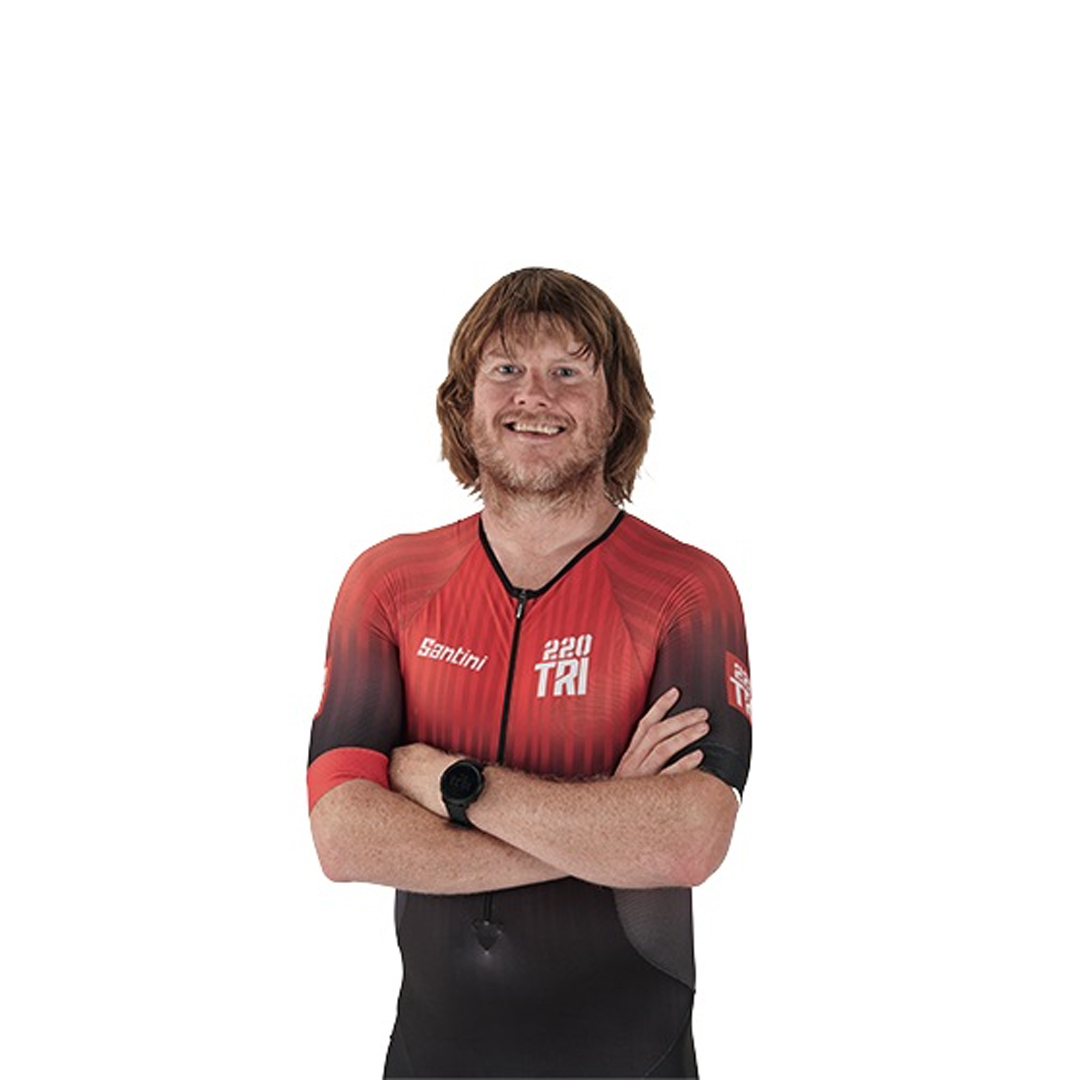“I’ve always felt like the bridesmaid at the world championship,” Lucy Charles-Barclay reflected after her 2023 Kona victory. And with good multisport matrimonial reason, finishing second in Kona in 2017, 2018, 2019 and 2022.
Those near-misses were left in the past on the Kona lava fields in October 2023 as she stormed to a new course record of 8:24:31. An incredible performance that planted the ceremonial cranial garland upon a British triathlete’s head for the first time in 12 years, after Leanda Cave’s win in 2011.
But what had changed to send the Hertfordshire Ironwoman to the peak of the podium? Experience helps, of course. But what specifically?
It’s clear that remaining cool in the hot and humid environs of Hawaii played an integral role in the masterplan. So here’s how Charles-Barclay simulated the heat of Hawaii… and what it feels like for a recreational athlete (your humble writer) to do similar…
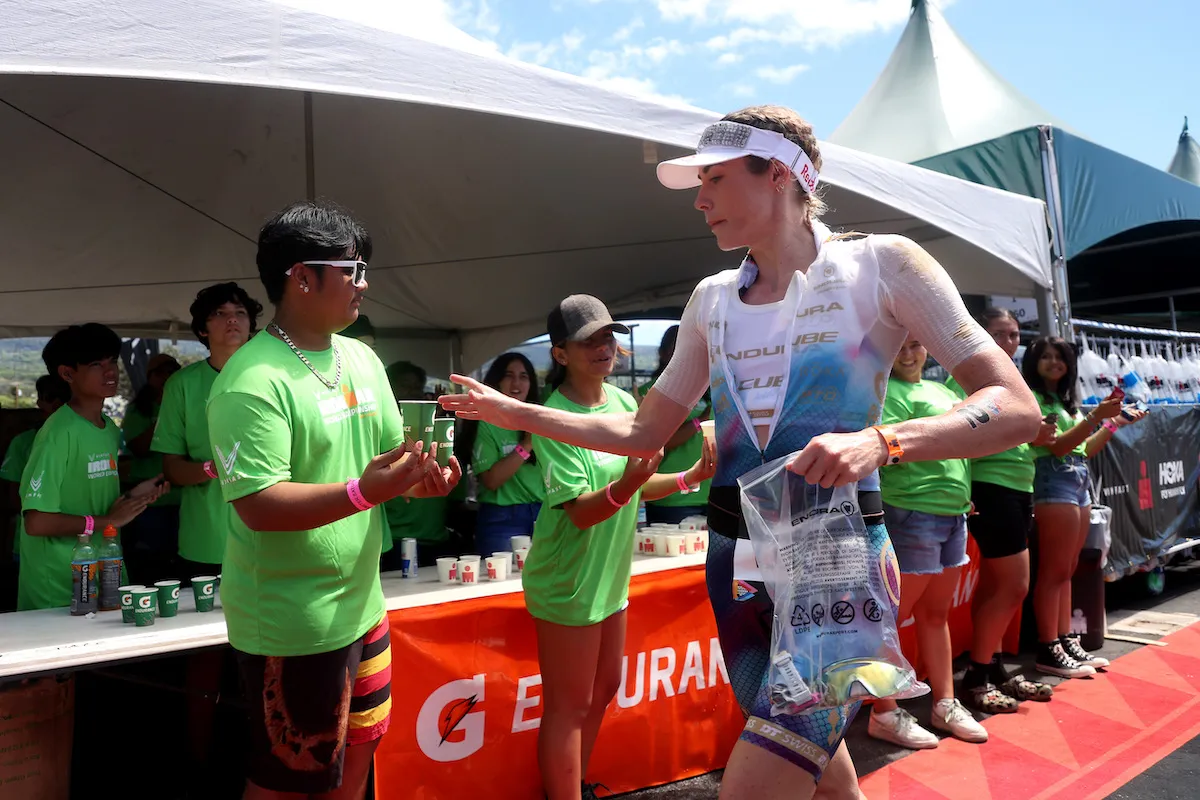
The home lab
Click on the Charles-Barclay vlog that went live a day before Ironman Hawaii and you’ll be greeted by a sweltering Lucy turbo training against the backdrop of an empty washing basket while being fanned down with a bodyboard by her coach-on-the-ground and husband, Reece.
The couple had switched from their preparation base of Lanzarote to train at home in the UK where they used heaters to crank up the temperature in an effort to acclimate to the heat and humidity of Hawaii.
“She’s had a very controlled environment,” Reece commented in the build-up. “I could set the temperature exactly and make sure she was having the right nutrition and hydration every hour. It was like being in a lab for six weeks.”
It’s that precise acclimation strategy, devised by Dan Lorang who oversees Charles-Barclay’s plan and who also steered Anne Haug to second, that’s of interest as just 10 days before Charles-Barclay became the third Brit ever to win the Ironman Worlds, we headed to the Porsche Human Performance Centre at Silverstone, taking up a sadistic invite from nutrition outfit Precision Fuel & Hydration to experience the conditions of Kona for ourselves.
Prepping to peak
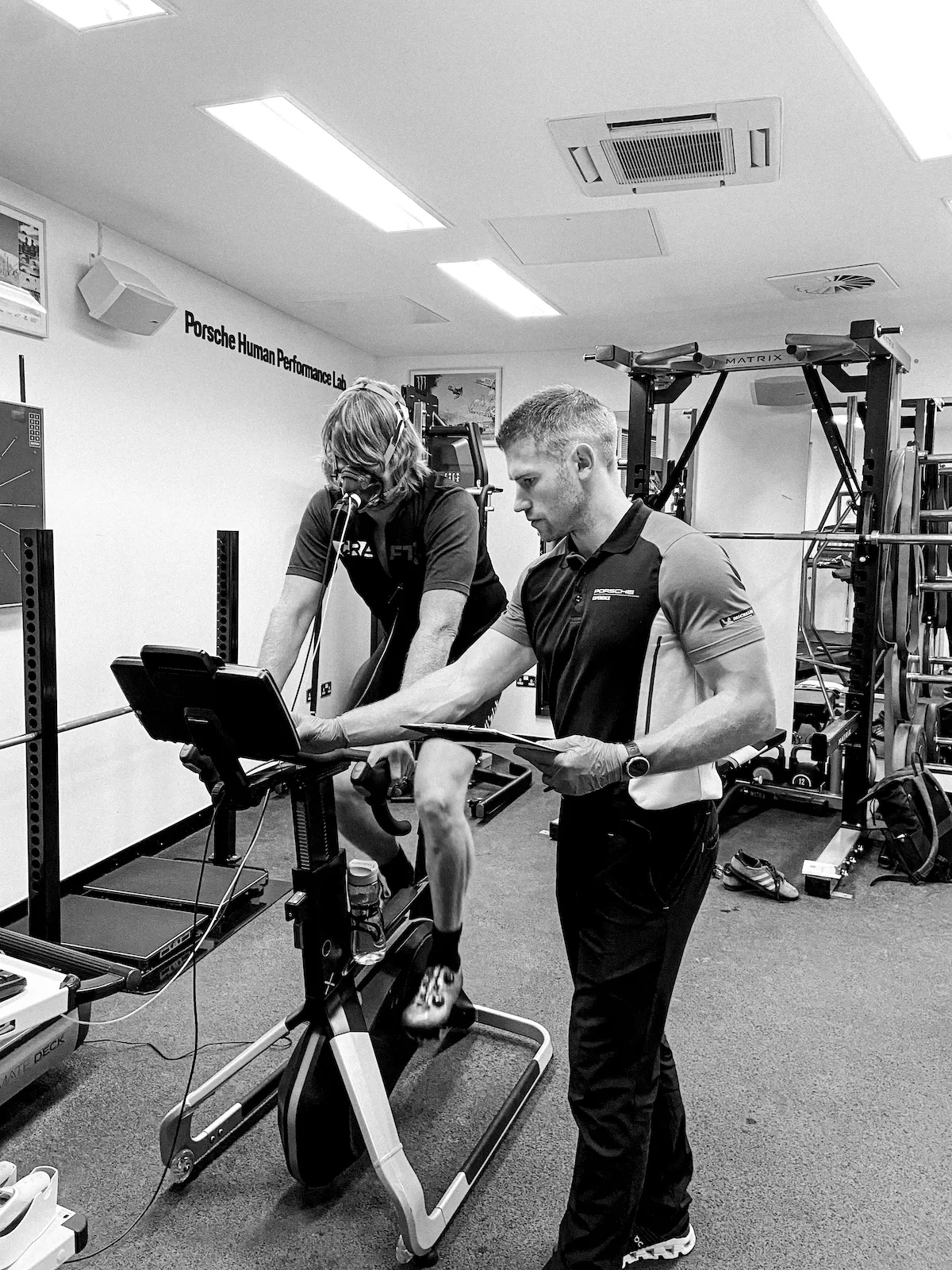
“The chamber’s dialled into 40°C,” says lead physiologist Jack Wilson. “We can’t change the humidity so it’s higher than the humid 31-32°C of Hawaii based on the heat index figures.”
The heat index, also known as “apparent temperature”, is what the temperature feels like to the human body when relative humidity is combined with air temperature.
A memory floods over me. It’s 2008 and an industrial-sized fan blasts cool air over me after being dragged out of a heat chamber by Dr Simon Hodder of Loughborough University. I’d visited to endure the conditions athletes would face in the upcoming Beijing Olympics.
The temperature dial cranked up to 32°C and 90% humidity to match those of China’s capital. The plan? To run on a treadmill for half-an-hour. The reality? I lasted 20mins before my core temperature, observed by Hodder via a core pill I’d swallowed a few hours previous, reached worrying levels.
“You’ll be fine,” Wilson says, smelling the trepidation. “It’s just a VO2 max test first.” Brilliant. Thankfully, said aerobic test, upon a static bike with a gas mask clamped to my face, took place outside the torture chamber.
My result of 47ml/kg/min is poor by elite standards but in the “excellent” category for a 46-year-old. A welcome ego boost before I melt on the treadmill for part two of the Kona brick session. And I could, says senior sports scientist Chris Harris as he enters the lab.
"Limiting core temperature is key to success in Hawaii,” he says. “Because it’s so hot, you can’t offload heat proficiently.
"It’s why in Hawaii, athletes will be shoving rags filled with ice into their tri-suits that they’ve picked up from a feed station. In fact, we’ve developed ice bandanas that you tie around your neck. You have a lot of thermoreceptors there so it’s a big driver of how you feel.”
Cooling the skin to cool the core is vital as that impacts a number of physiological systems. When training or racing in the heat, core temperature will climb from around 37-38°C to 39-40°C and possibly beyond, with heat exhaustion likely between 40-41°C.
As a snapshot, this rise in temperature alters brain chemistry and impairs cognitive function. It also changes gut bloodflow, causing leakage into the system; increases free radical damage… It’s not simply a case of core temperature rises and you feel uncomfortable.
“I’ll monitor you via an ear thermometer,” Wilson says as he opens the hot glass coffin. “I’ll pop in every 5mins and the session is 30mins. Run at a comfortable pace. If you reach 39.5°C, you’re out.”
The heat wraps itself around me upon entering. Cue, I’ll stick at 10km/hr run pace. That’s relatively easy in normal climes. But this heat isn’t normal for a 6ft 3in, 90kg man who lives aside the cool Bristol Channel.
(For comparison, Charles-Barclay’s 2:57:38 Hawaii run came via an average 4:11mins per kilometre. This, of course, off the back of a 49:36min swim and 4:32:29 bike. Humbling.)
“Okay, go,” says Wilson. “Your core temperature is 37.5°C.”
Struggling for breath
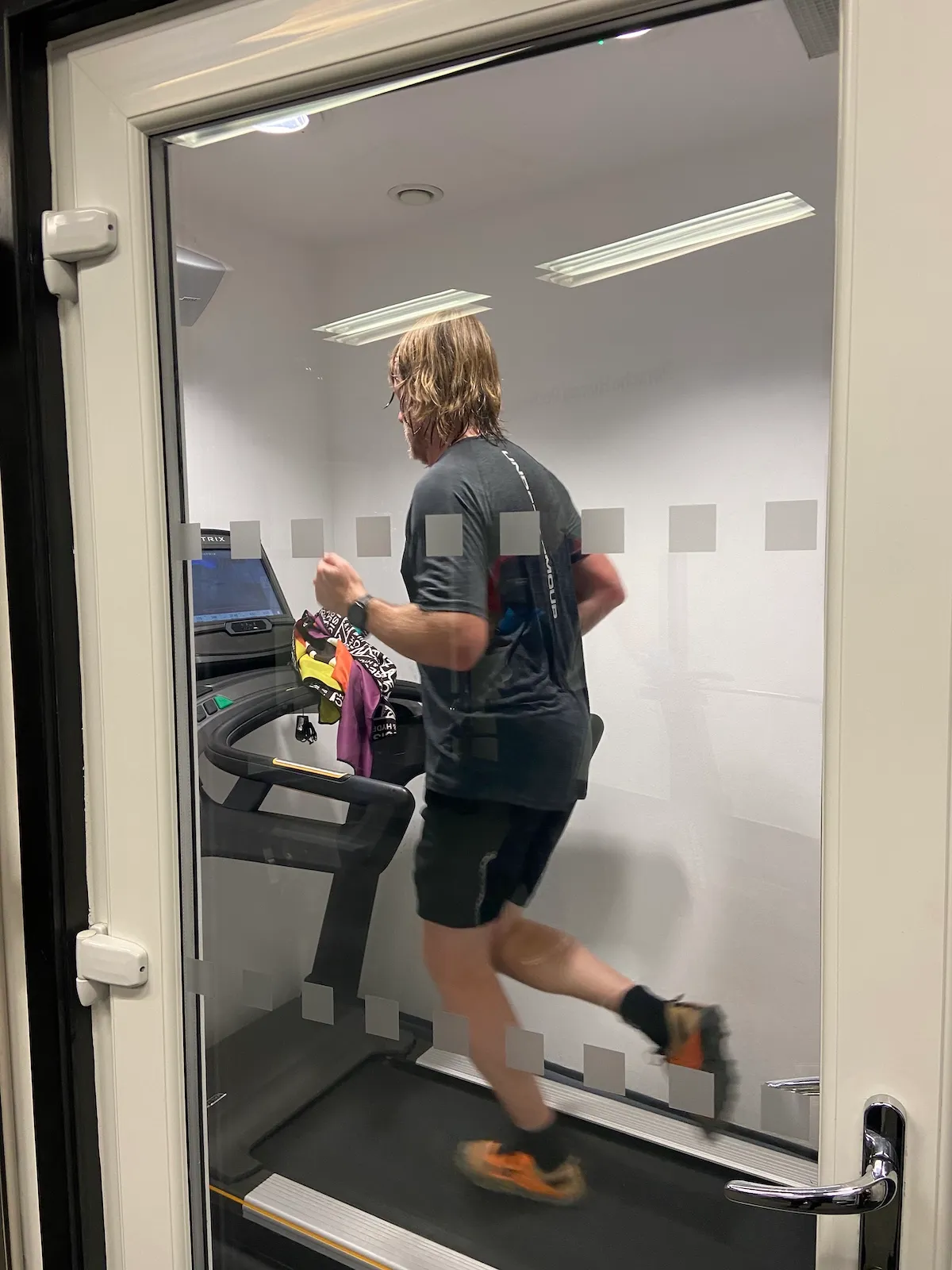
As it remains for 10mins. It’s a surprise as with each passing second, the heat becomes more oppressive. It’s seemingly not reflected in my furnace. But it is in my bellows, as inhaling heated air is unnerving.
My lungs feel squeezed, sending my heart rate to 159bpm. My max is around 178bpm. This is ‘easy’ pace but no-one informed my frying cardiovascular system.
To cool my core, I drink water from my water bottle. Though painful, this run’s only 30mins. Longer and I’d drop an electrolyte tablet, of which our hosts, Precision Fuel & Hydration, are experts, offering a range of sodium products based on your sweaty, sodium content (more shortly).
Among myriad functions, sodium helps to maintain blood plasma volume and transport water from the bloodstream to working muscles. If the triathlete’s drinks contain water with little sodium, much will leach out into their soggy chamois.
Which could be happening now as, 25mins in, I’m drenched, albeit my core remains moderate at 38.8°C. The competitor in me feels I should at least tip over 39°C, so I shift up to 11km/hr for the final 5mins.
And I’m glad it’s just 5mins as a single km/hr extra’s akin to sprinting like Usain Bolt in a hazmat suit (which many athletes do wear for acclimatory purposes, by the way, including former triathlete Dan Bigham, who wore one in his build-up to breaking the hour record in August 2022).
Thirty minutes is up. I storm out and catch a cooler breath. My heart rate’s shot up to 178bpm accompanied by a core increase to 39.3°C.
“Not a bad effort for someone who’s not acclimated,” says Wilson. I certainly wasn’t, heading over to Silverstone earlier that morn from the less-than-tropical Clevedon.
Charles-Barclay had mastered the art – and a hint of science – in her steaming pain cave, resulting in a cascade of adaptations conducive to if not improving performance in the heat, at least reducing the heat-fuelled losses.
“The main adaptation you’re after is increased blood plasma volume, which reduces heart rate, and an increase in sweat rate,” says Harris. “You want your body to sweat more because more sweat equals better cooling.
“And there are plenty of ways to acclimate [creating an artificially hot environment rather than acclimatisation, which is the hot environment you’re racing in].
"In the past, I’ve seen one of our athletes, Fenella Langdridge, tape plastic sheets all around her spare room to increase humidity. She adds a heater, turns up the radiator and cycles away. It’s effective but expensive!
“The good thing about preparing your body for the heat is that the physiological changes happen quickly. We’ve seen results in three or four days when exercising easy for an hour a day. That said, optimally you’re looking at 10 to 14 days. Anything after that is diminished returns.”
Sprinkling of sodium
Wiped down, showered and changed, I head for a sweat test, which involves a machine created to measure salt levels in cystic fibrosis sufferers.
The test is simple. Two electrodes are placed on my arm, which contain gel discs saturated in the chemical pilocarpine before strapping them down. The ‘sweat inducer’ is switched on and a current flows through the wires. I don’t feel a thing.
The charged pilocarpine stimulates localised sweat production. The gel discs are replaced with a sweat collector, which contains a blue dye so the team can observe it reaching a third full, enough to fill the analyser.
The team connects the collector to the analyser and, after analysis, it transpires I’m a moderate sodium sweater, coming in at 1,024mg/l. Very low is 200-300mg/l; very high is just over 2,000.
This figure’s combined with sweat rate to give you a hydration plan. From my results, I lost 0.69kg of sweat in just 30mins. That equates to a predicted sweat rate of 1.38l/hr.
From my results, 1,024mg of sodium is lost in each litre of sweat. That’s 1,413mg an hour. To replenish stocks, Precision offer sodium tablets at 500mg, 1,000mg and 1,500mg with each fizzy pill popped in 500ml of water.
For me, I’m looking at the 1,000mg option as I’d struggled to drink 1.5 litres an hour. Your stomach can only cope with so much, too, before it becomes bloated and uncomfortable.

How does that compare to the elites? “This is Leon’s breakdown from Nice,” explains Harris, showing me the data of France’s Leon Chevalier, who finished fifth at the men’s Ironman World Championships in Nice, France, in September.
“His sodium content is 1,331mg per litre. It was hot [26°C], but not as hot as Hawaii, and he took in 805mg sodium per litre, drinking 732ml an hour. It would have been more but one of his bottles flew off!”
Chevalier commented after the race, “I never felt ‘thirsty’ but I noticed I had less fluid available to me towards the end of the run, likely because there were more age-groupers going through the aid stations on the out-and-back course, taking cups of water at the same time as me.”
Harris then applauds Leon’s stablemate, Langridge, who he says always nails the sodium strategy. “We have 250mg sodium capsules that Fenella prefers. She takes one every 15mins on the bike.”
It’s all about preparation, is the take-home tip. Mastering acclimation and racing in the heat requires a diligent and practised plan.
As temperatures tip over 30°C, there are too many physiological variables that could unravel to leave things to chance.
We’re not saying you should spend every off-season session cranking up the thermostat and pedalling away. But even indoor training without the heat up, and losing the fan, creates an environment that’ll stimulate adaptations conducive with not only peak performance when it’s hot but in the cold, too.
With that in mind, take a look at the ‘Heat benefits in the cold’ below. And then enact some of the ideas mooted in the ‘Adapt from home’ box, bottom. Enjoy a session or two of sweat-fuelled speed for all-year improvements!
Heat benefits in the cold
When the nights are long and temperatures are dropping, you should adopt a spot of heat training. Here's why…
A growing body of research suggests that training in the heat can pay off when racing in cooler climes.
In 2010, researchers from Oregon University had 12 strong cyclists ride for 100mins a day for 10 days on stationary bikes in an extreme condition, namely the 40°C I endured in the Silverstone sweat fest.
Humidity nestled at a more palatable 50%. Come the end of the hot block, across the board VO2 max at cooler climes had risen by a notable 5% compared to the control group.
The performance impact was an 8% improvement in TT time in the cold.
Why seems to be down to a physiological adaptation sought when training at altitude, namely an increase in red blood cells to carry more oxygen that can more readily and more numerically fuel the muscle furnace.
In the heat case, it’s about creating a stress response in cells – for instance, that plasma volume change we talked about – that the triathlete can benefit from in the cold.
How to adapt to the heat from home
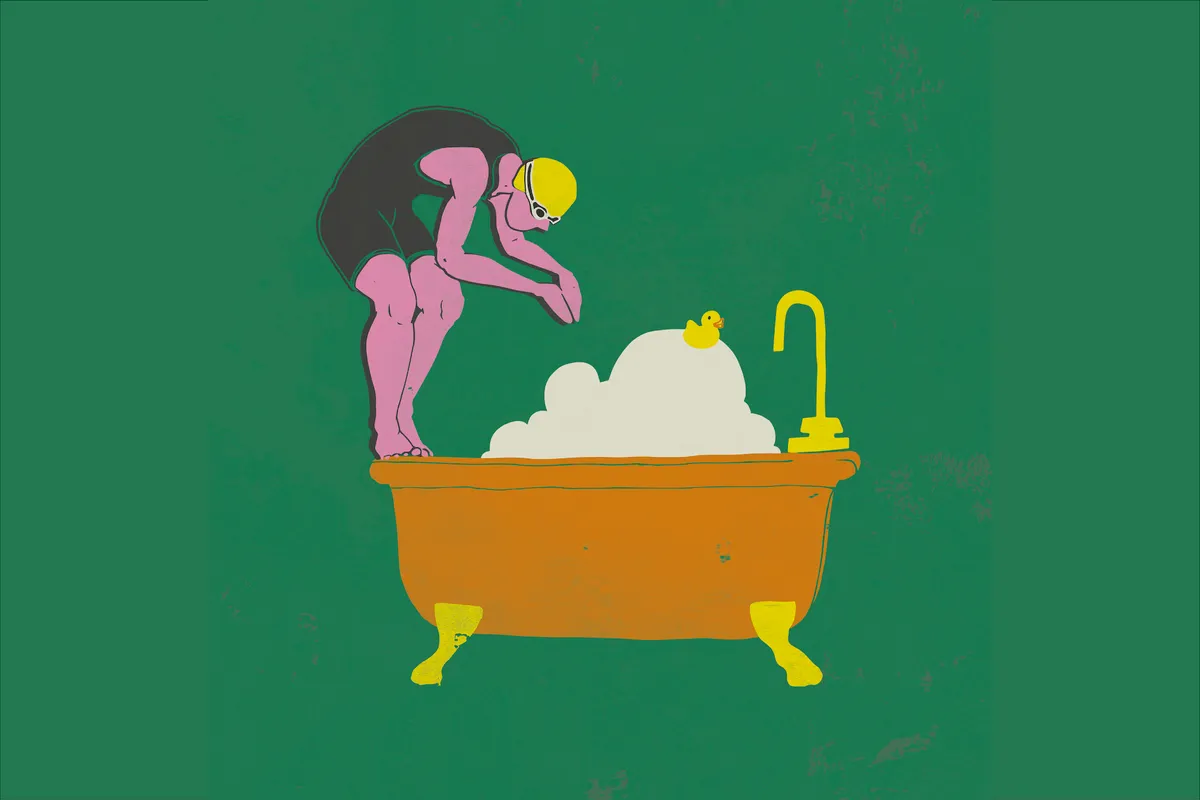
Race like a demon in the heat via a nice, relaxing bath…
Research by Professor Neil Walsh showed that taking a hot bath after exercise improves performance in the heat.
Walsh’s study showed that athletes bathing in 40°C waters for up to 40mins for six successive days stimulated adaptations that are beneficial in the heat, like an increased sweat rate and lower heart rate, improving their 5km treadmill time in the heat. You can, however, bathe for as little as 15mins.
Layering up on the run will also stimulate adaptations, albeit to a lesser extent. Besides the heat, there isn’t too much else. Then again, deliberate practice of nasal breathing is one method used by some athletes but its empirical evidence is limited.
Top image credit: Haffey/Getty Images for Ironman
